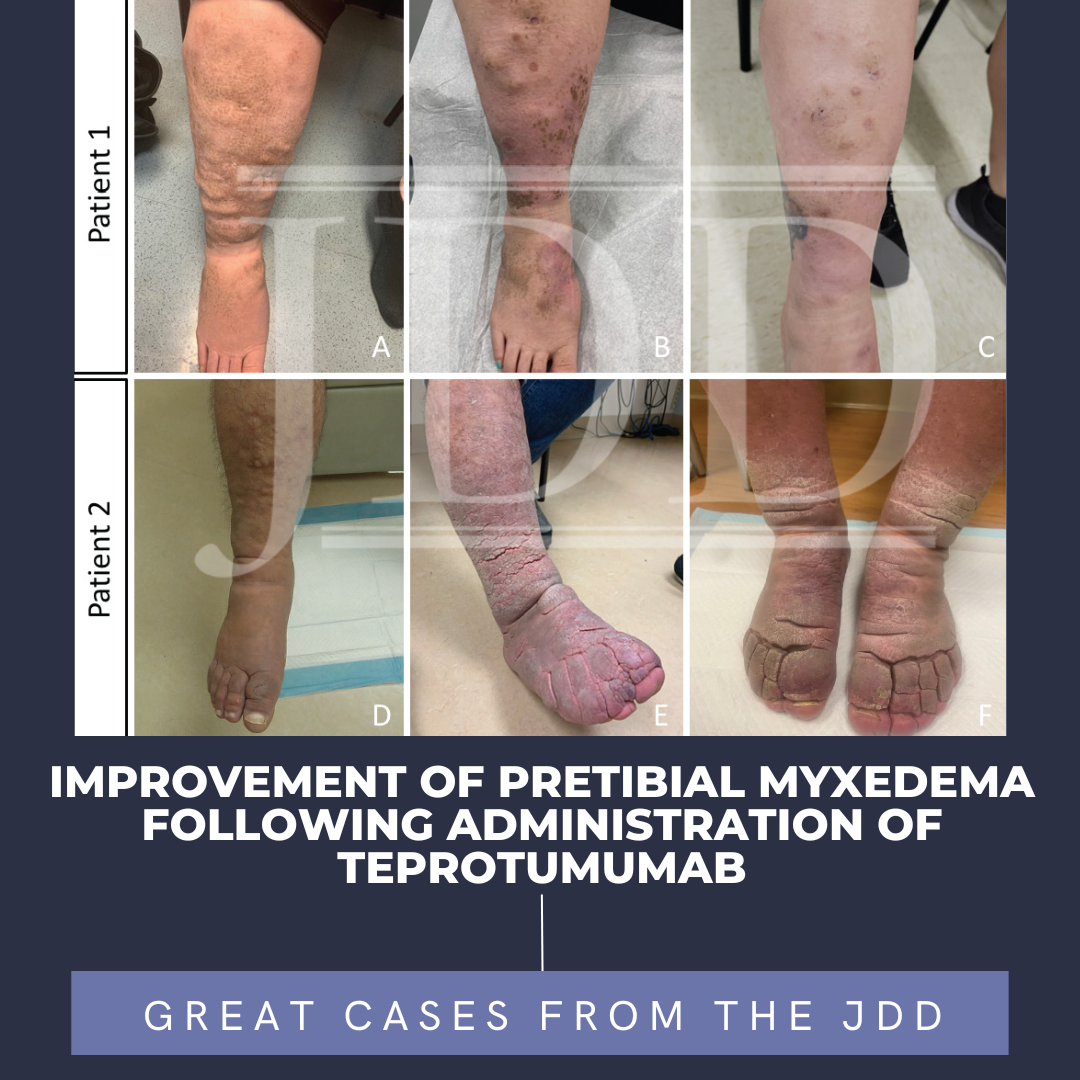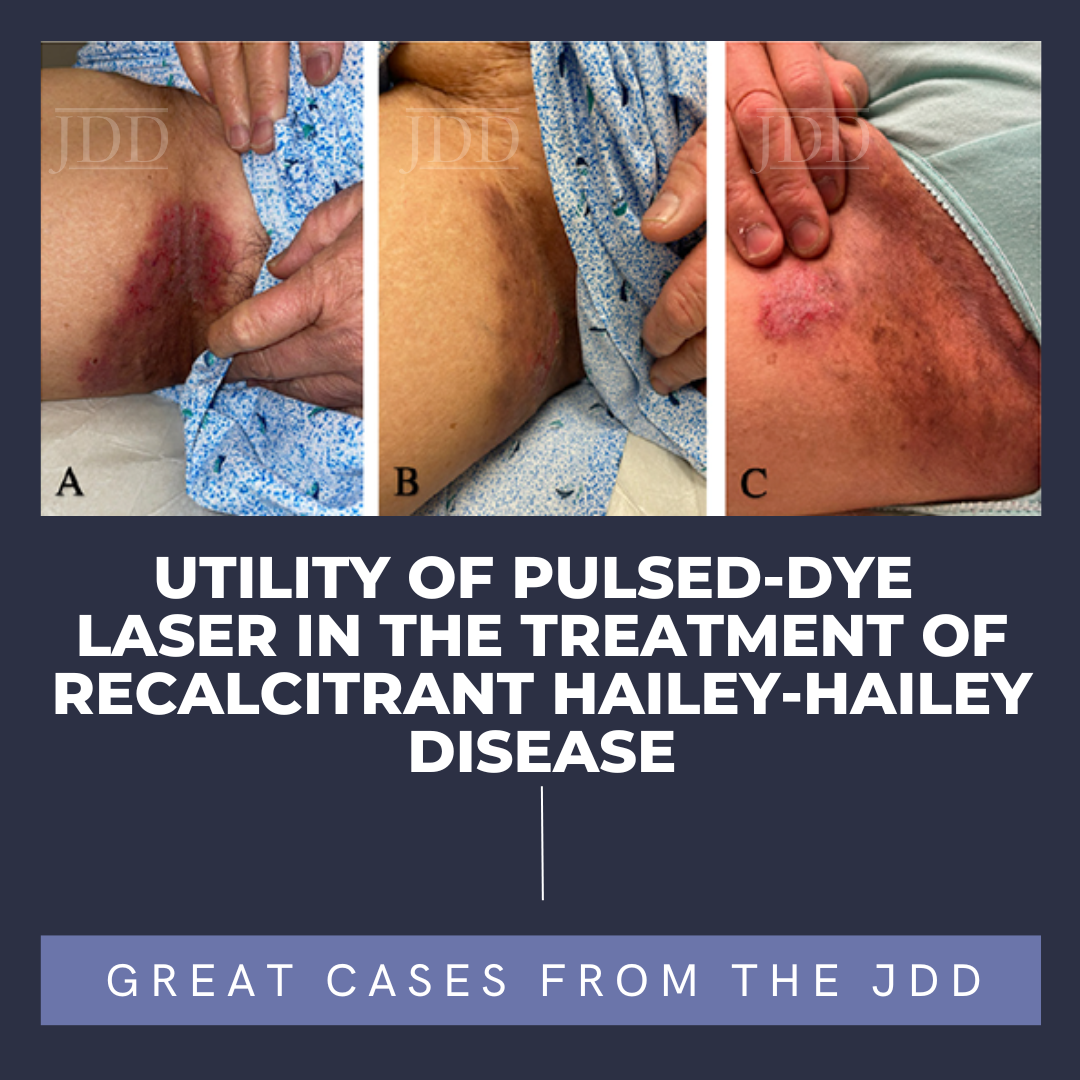Improvement of Pretibial Myxedema Following Administration of Teprotumumab
 Pretibial myxedema (PTM) is a rare complication of Graves' disease. It is characterized by non-pitting edema with hyperpigmented hyperkeratotic papules and plaques on bilateral lower legs. Effective treatments for patients with PTM are lacking. The etiology of PTM is unknown; however, it may be similar to the mechanism of thyroid-associated ophthalmopathy (TAO). Activated fibroblasts produce infla …
Pretibial myxedema (PTM) is a rare complication of Graves' disease. It is characterized by non-pitting edema with hyperpigmented hyperkeratotic papules and plaques on bilateral lower legs. Effective treatments for patients with PTM are lacking. The etiology of PTM is unknown; however, it may be similar to the mechanism of thyroid-associated ophthalmopathy (TAO). Activated fibroblasts produce infla …
 Pretibial myxedema (PTM) is a rare complication of Graves' disease. It is characterized by non-pitting edema with hyperpigmented hyperkeratotic papules and plaques on bilateral lower legs. Effective treatments for patients with PTM are lacking. The etiology of PTM is unknown; however, it may be similar to the mechanism of thyroid-associated ophthalmopathy (TAO). Activated fibroblasts produce infla …
Pretibial myxedema (PTM) is a rare complication of Graves' disease. It is characterized by non-pitting edema with hyperpigmented hyperkeratotic papules and plaques on bilateral lower legs. Effective treatments for patients with PTM are lacking. The etiology of PTM is unknown; however, it may be similar to the mechanism of thyroid-associated ophthalmopathy (TAO). Activated fibroblasts produce infla … Continue reading "Improvement of Pretibial Myxedema Following Administration of Teprotumumab"


 The Journal of Drugs in Dermatology welcomes 2024 with a strong line up of original articles, case reports, brief communications, and letters to the editor. Straight from the Editor's desk, we share this month's issue highlights!
ORIGINAL ARTICLES
Current Landscape of Hyaluronic Acid Filler Use in the United States shares the results of a comprehensive search of all the FDA approved dermal fill …
The Journal of Drugs in Dermatology welcomes 2024 with a strong line up of original articles, case reports, brief communications, and letters to the editor. Straight from the Editor's desk, we share this month's issue highlights!
ORIGINAL ARTICLES
Current Landscape of Hyaluronic Acid Filler Use in the United States shares the results of a comprehensive search of all the FDA approved dermal fill …  INTRODUCTION
Benign Familial Pemphigus, or Hailey-Hailey Disease (HHD), affects intertriginous areas of the skin causing epidermal blistering and vesicles that coalesce into weeping and crusting plaques.¹
The loss-of-function mutation of the ATP2C1 gene causes a disruption in calcium homeostasis of keratinocytes. The resulting dysfunction in desmosomes and cell-cell adhesion causes acanthol …
INTRODUCTION
Benign Familial Pemphigus, or Hailey-Hailey Disease (HHD), affects intertriginous areas of the skin causing epidermal blistering and vesicles that coalesce into weeping and crusting plaques.¹
The loss-of-function mutation of the ATP2C1 gene causes a disruption in calcium homeostasis of keratinocytes. The resulting dysfunction in desmosomes and cell-cell adhesion causes acanthol …  Welcome to the December 2023 issue of the Journal of Drugs in Dermatology (JDD), where cutting-edge research and advancements in the field of dermatology take center stage. This issue brings together a diverse array of original articles, case reports, brief communications, and letters to the editor and delves into the latest developments, therapeutic breakthroughs, and cl …
Welcome to the December 2023 issue of the Journal of Drugs in Dermatology (JDD), where cutting-edge research and advancements in the field of dermatology take center stage. This issue brings together a diverse array of original articles, case reports, brief communications, and letters to the editor and delves into the latest developments, therapeutic breakthroughs, and cl …  JDD authors Mihir Shah MD, Jenna Wald MD, and C. William Hanke MD MPH present a case of a patient with eruptive squamous cell carcinomas following treatment with Fludarabine to highlight not only the risk of cSCC in CLL patients and the increased risk for atypical cutaneous malignancies after treatment with systemic therapies such as fludarabine, but also to discuss treatment options for this …
JDD authors Mihir Shah MD, Jenna Wald MD, and C. William Hanke MD MPH present a case of a patient with eruptive squamous cell carcinomas following treatment with Fludarabine to highlight not only the risk of cSCC in CLL patients and the increased risk for atypical cutaneous malignancies after treatment with systemic therapies such as fludarabine, but also to discuss treatment options for this …